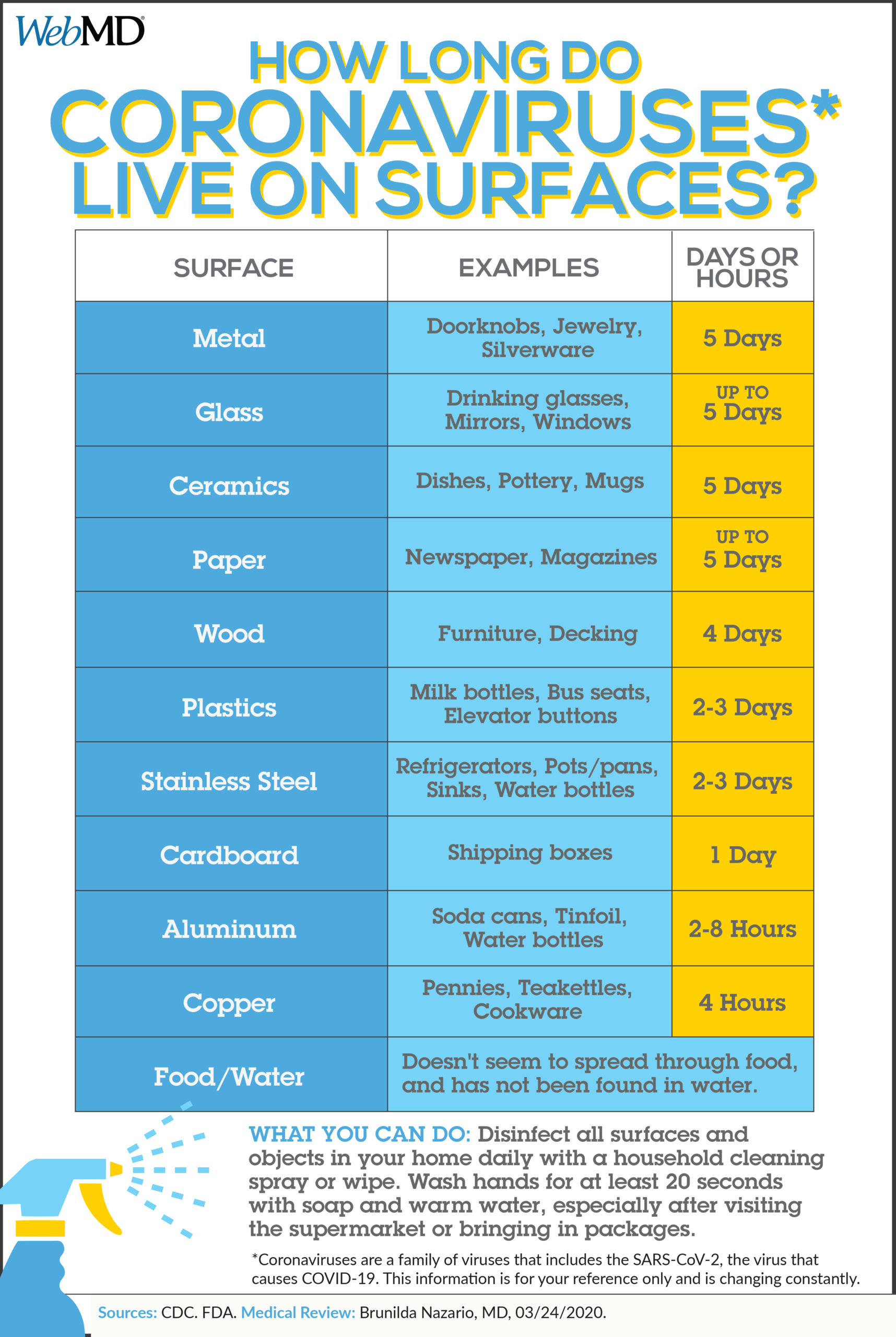How Long Do Coronaviruses Live on Surfaces?
(Source: WebMD)

Download the “How Long Do Coronaviruses Live on Surfaces” PDF
The coronavirus that causes COVID-19 mainly spreads from person to person. When someone who is infected coughs or sneezes, they send droplets containing the virus into the air. A healthy person can then breathe in those droplets. You can also catch the virus if you touch a surface or object that has the virus on it and then touch your mouth, nose, or eyes.
The coronavirus can live for hours to days on surfaces like countertops and doorknobs. How long it survives depends on the material the surface is made from.
Here’s a guide to how long coronaviruses — the family of viruses that includes the one that causes COVID-19 — can live on some of the surfaces you probably touch every day.
Keep in mind that researchers still have a lot to learn about the new coronavirus. But you’re probably more likely to catch it from being around someone who has it than from touching a contaminated surface.
Different Kinds of Surfaces
Metal
Examples: doorknobs, jewelry, silverware
5 days
Wood
Examples: furniture, decking
4 days
Examples: milk containers and detergent bottles, subway and bus seats, backpacks, elevator buttons
2 to 3 days
Examples: refrigerators, pots and pans, sinks, some water bottles
2 to 3 days
Examples: shipping boxes
24 hours
Examples: pennies, teakettles, cookware
4 hours
Examples: soda cans, tin foil, water bottles
2 to 8 hours
Examples: drinking glasses, measuring cups, mirrors, windows
Up to 5 days
Examples: dishes, pottery, mugs
5 daysPaper
Examples: mail, newspaper
The length of time varies. Some strains of coronavirus live for only a few minutes on paper, while others live for up to 5 days.
Food
Examples: takeout, produce
Coronavirus doesn’t seem to spread through food.
Water
Coronavirus hasn’t been found in drinking water. If it does get into the water supply, your local water treatment plant filters and disinfects the water, which should kill any germs.
Fabrics
Examples: clothes, linens
There’s not much research about how long the virus lives on fabric, but it’s probably not as long as on hard surfaces.
What You Can Do
To reduce your chance of catching or spreading the new coronavirus, clean and disinfect common surfaces and objects in your home and office every day. This includes:
- Countertops
- Tables
- Doorknobs
- Bathroom fixtures
- Phones
- Keyboards
- Remote controls
- Toilets
Use a household cleaning spray or wipe. If the surfaces are dirty, clean them first with soap and water and then disinfect them.
You can also make a bleach solution that will be good for up to 24 hours. Mix 5 tablespoons (one-third cup) of household bleach per gallon of water, or 4 teaspoons per quart of water. Never mix bleach with ammonia or another cleanser. Leave cleaners or bleach solutions on surfaces for at least 1 minute.
Keep surfaces clean, even if everyone in your house is healthy. People who are infected may not show symptoms, but they can still shed the virus.
Wash your hands with soap and warm water for at least 20 seconds after you visit the drugstore or supermarket or bring in takeout food or a delivered newspaper.
It’s a good idea to wash fruits and vegetables under running water before you eat them. Scrub them with a brush or your hands to remove any germs that might be on the surface. If you have a weakened immune system, you might want to buy frozen or canned produce.
There’s no evidence that anyone has gotten the virus from food packaging. But if you want, you can wipe down take-out containers or grocery items and let them air dry.



Leave A Comment